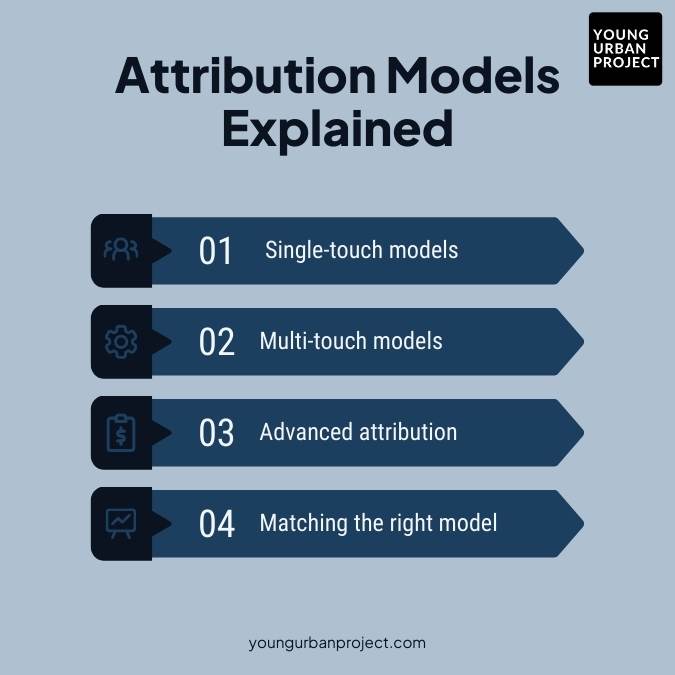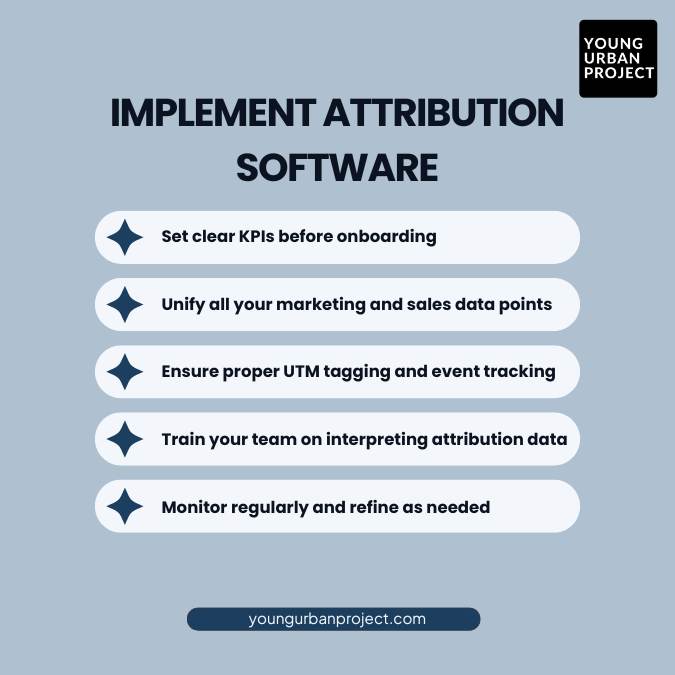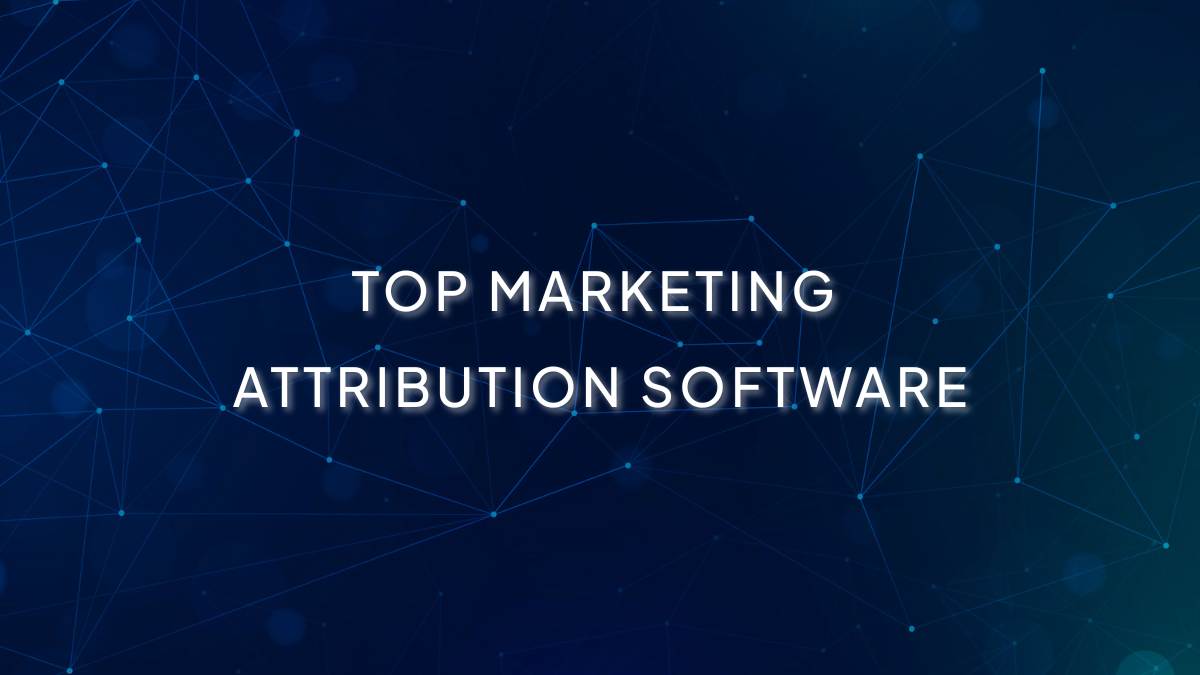Marketing teams are tired of guessing what’s working. You’re spending money on ads, email, content, maybe even influencers. But which of these is actually bringing in sales? That’s the big question, and marketing attribution is the answer. Attribution tools help you track which touchpoints are driving real results. No more relying on gut feelings. In this blog, we’ll walk you through how attribution works, what models you can use, and the best Marketing Attribution Software to start with. Let’s get into it.
Table of Contents
Understanding the Role of Marketing Attribution
What is marketing attribution in simple terms?
Marketing attribution is a way to figure out what channels help a customer take action, like buying or signing up. It tracks their journey across different platforms, so you know which effort made the most impact.
How it aligns campaigns with actual outcomes
Attribution connects your marketing campaigns to real business results. It helps you see what led to clicks, conversions, or sales, so you stop wasting money on what doesn’t work.
Key reasons why attribution is now essential for performance marketers
Marketing budgets are tight, and competition is high. Attribution helps marketers make smarter choices, show real ROI, and plan better campaigns. Without it, you’re basically flying blind.
Attribution Models Explained: From First to Last Click

1. Single-touch models: First-click vs. last-click
First-click gives all credit to the first thing a user sees. Last-click gives credit to the final action before they converted. Both are easy to track, but miss the bigger picture.
2. Multi-touch models: Linear, time decay, and position-based
These models share credit across touchpoints. Linear splits it equally. Time decay gives more value to recent actions. Position-based favors the first and last touches most.
3. Advanced attribution: Data-driven and AI-powered models
These models use machine learning to figure out which steps had the most impact. They’re smarter but need more data and setup. Great for teams that want deep insights.
4. Matching the right model to your sales cycle and funnel complexity
Simple funnels might do fine with single-touch models. However, if your customer journey has many steps (like in B2B), multi-touch or data-driven models give better answers.
Also Read: Top Marketing Planning Software Tools
Features That Make a Great Attribution Tool
1. Cross-channel journey tracking
A good tool should track user activity across platforms, ads, emails, social, and even offline. It should help you follow a buyer’s full path, not just the final click.
2. Real-time performance insights
You don’t want to wait days to know what’s working. Real-time insights let you adjust fast, test better, and respond to changes as they happen.
3. Seamless integration with CRMs, ad platforms, and analytics tools
The best tools connect easily with the software you already use, like HubSpot, Google Ads, or Salesforce. This keeps your data clean and connected.
4. Custom reporting for stakeholders
Different teams need different views. Your tool should let you build custom reports for marketing, sales, or the C-suite, without needing a data expert.
5. Data visualization & collaboration features
Clear charts and dashboards make it easier to understand what’s going on. Bonus if your team can share notes or tag issues directly in the platform.
Also Read: Best AI SEO Tools to Boost Rankings
Best Marketing Attribution Software Tools in 2025
1. HubSpot Marketing Hub
Best For: Marketers who want an all-in-one CRM + marketing suite with native attribution reports
Pricing: Starts free; for paid plans, visit their website.
Key Features:
- Multi-touch attribution built-in
- Ties marketing to revenue via CRM
- Easy to use, visual dashboards
- Works well for small to mid-sized teams
If you’re already using HubSpot for your CRM or emails, then you’re sitting on a goldmine of attribution data. HubSpot Marketing Hub brings everything together, email, landing pages, social, and contacts, into one place. Its attribution tools are surprisingly robust for an all-in-one platform, especially considering how beginner-friendly it is. Ideal for growing teams who want less tool-hopping.
2. Ruler Analytics
Best For: Businesses that rely heavily on calls and form fills, especially in service-based industries
Pricing: Starts around £179/month, paid annually.
Key Features:
- Closed-loop revenue attribution
- Call tracking integrated with ad data
- Syncs with CRMs like HubSpot and Salesforce
- Tracks offline conversions (like phone sales)
Ruler Analytics stands out by overcoming a common hurdle: accurately tracking how online leads translate into offline conversions. It’s a closed-loop attribution tool, meaning it doesn’t just stop at the lead; it tracks the full customer journey from click to call to sale. Especially powerful for agencies and service-based businesses that rely on phone calls or manual follow-ups.
3. LeadsRx
Best For: Marketers juggling both digital and offline campaigns who want real-time attribution
Pricing: Custom pricing based on business size (starts mid-tier)
Key Features:
- Real-time, multi-touch attribution
- Includes offline touchpoints like radio or TV
- Cross-device and cookie-less tracking
- Unified customer view across channels
If you’re running omnichannel campaigns, think podcasts, Google Ads, email, and even direct mail, LeadsRx helps you piece it all together. It’s not the most beginner-friendly platform, but its multi-touch attribution engine is crazy powerful. Real-time updates and support for offline channels make it perfect for bigger brands and agencies who need more than just last-click data.
4. Usermaven
Best For: Startups and product-led companies that want insights without needing developers
Pricing: Free tier available; paid plans from $12/month billed annually.
Key Features:
- No-code event tracking
- AI-generated insights
- Clean, modern UI
- Attribution across funnel stages
Usermaven caters to the modern marketing professional by offering powerful insights that don’t require any coding expertise. You can track events, conversions, and user journeys with almost zero technical setup. Add in AI-powered insights and a slick interface, and it’s easy to see why this tool is gaining traction fast with startups and bootstrapped SaaS businesses.
5. Mixpanel
Best For: SaaS and product teams focused on user behavior across their apps or platforms
Pricing: Free plan (up to 1M events), Growth plan (paid, up to 20M events), and Enterprise plan (custom, up to 1T events), with a free Startup Program for eligible companies.
Key Features:
- Tracks product usage, not just website visits
- Funnels, cohorts, and retention reports
- Powerful event-based tracking
- Works well with mobile + web apps
Mixpanel isn’t your typical marketing attribution tool — it’s more like a product analytics powerhouse with attribution capabilities baked in. Perfect for SaaS and tech companies that care about how users behave after they sign up. If you’re obsessed with understanding churn, retention, and what features lead to conversions, Mixpanel deserves your attention.
6. Segment (by Twilio)
Best For: Teams that need to unify scattered customer data across multiple platforms
Pricing: Free for basics; paid plans from $120/month (Team), custom for Business
Key Features:
- Centralizes data from 200+ tools
- Clean customer profiles for attribution
- Supports real-time event tracking
- Works as a “data pipeline” for your stack
Segment doesn’t do attribution out of the box, it gives you the clean data layer needed to do it right. It acts like a hub that collects and distributes your customer data to all your tools (like GA4, Mixpanel, or Facebook Ads). If your attribution is messy, the problem may actually be your data. That’s where Segment saves the day.
7. Google Analytics 4 (GA4)
Best For: Budget-conscious marketers who want flexible (but sometimes complex) attribution
Pricing: Free (GA4); GA4 360 starts at $50,000/year for enterprise
Key Features:
- Multiple attribution models (data-driven, first-click, etc.)
- Event-based tracking system
- Integrates with Google Ads natively
- Cross-device + cross-platform analysis
GA4 isn’t perfect, and the learning curve is real, but it’s still one of the most powerful (and free) tools for attribution. Google’s data-driven attribution model uses machine learning to distribute credit across touchpoints, not just the last one. If you can get past the interface quirks, GA4 gives surprisingly deep insights, especially when paired with BigQuery or Looker Studio.
8. Heap
Best For: Teams that want automatic, retroactive tracking of user behavior
Pricing: Free plan available; paid plans are custom (mid- to high-tier pricing)
Key Features:
- Auto-captures user interactions (no setup required)
- Visual journey maps and funnel analysis
- Retroactive data on past events
- Strong for product and marketing teams
The coolest thing about Heap? You don’t have to manually tag events. It just… captures everything. That means you can go back later and analyze user behavior, even if you hadn’t planned to track it before. It’s a game-changer for marketers who hate bugging devs for tracking code every time they launch a campaign.
9. Singular
Best For: Mobile-first brands running paid campaigns across multiple ad networks
Pricing: Custom (aimed at mid-to-enterprise level advertisers)
Key Features:
- Attribution + cost aggregation across 100+ networks
- Detailed ROI + ROAS reporting
- Mobile-first, but also supports web campaigns
- Anti-fraud tools built-in
Singular is built for performance marketers who live in spreadsheets and ad dashboards. It combines attribution with cost reporting so you can see exactly what you’re spending and what you’re earning, per channel, per campaign. If you’re scaling mobile ads across networks like Meta, TikTok, Snap, and beyond, Singular gives you a clean, unified view of it all.

Enroll Now: Live Digital Marketing Course
10. AppsFlyer
Best For: Mobile app marketers who care about deep-linking, user privacy, and fraud protection
Pricing: Free tier available; for paid plans, check out their website.
Key Features:
- Industry-leading mobile attribution
- Advanced deep-linking (OneLink)
- Built-in fraud protection suite
- Works with both iOS and Android
AppsFlyer is a staple in the mobile marketing world. It’s trusted by big players (like Nike and TikTok) for a reason, accurate attribution, bulletproof deep-linking, and a sharp focus on data privacy. If you’re marketing a mobile app and need to prove ROI across different ad networks, it’s honestly hard to beat.
11. Coupler.io
Best For: Marketers and analysts who need to pull data from multiple sources into visual dashboards
Pricing: Free tier available; paid plans start at $24 per month, billed annually.
Key Features:
- Connects to over 50 data sources (Google Ads, Facebook, HubSpot, etc.)
- Automates data exports to Google Sheets, Excel, Looker Studio
- Enables visual dashboards without coding
- Not a pure attribution tool, but enhances reporting accuracy
Coupler.io isn’t a traditional attribution tool, it’s more like the engine room for your marketing reports. It helps you pull raw data from your CRM, ad platforms, and analytics tools, then pushes it to your favorite spreadsheet or BI dashboard. If your team loves working in Google Sheets or Looker Studio but hates manual updates, Coupler is a serious time-saver.
12. Wicked Reports
Best For: E-commerce brands looking to attribute revenue across long sales cycles
Pricing: Get your first 14 days for $250 then $500 per/month
Key Features:
- Tracks customer journeys across email, ads, and purchases
- Includes first-click, last-click, and full-impact attribution models
- Syncs with platforms like Shopify, Klaviyo, Meta Ads, and Google
- Designed specifically for revenue-focused marketers
Wicked Reports is kind of a hidden gem for e-commerce attribution. It goes beyond clicks and gives you deep revenue insights — which ad drove the first click, which email closed the deal, and everything in between. It’s not cheap, but for DTC brands running Facebook and Google Ads at scale, it can really unlock high-quality decision-making.
13. Northbeam
Best For: DTC brands and performance marketers scaling on Meta, Google, and TikTok
Pricing: Starts around $1,000/month
Key Features:
- Real-time, multi-touch attribution
- Campaign-level ROAS and blended performance tracking
- Strong on predictive analytics and media planning
- Focused on paid media buyers
Northbeam is like a co-pilot for high-performance e-commerce teams. It’s built with paid media in mind and delivers accurate, cross-channel attribution even when tracking pixels get blocked. The platform’s biggest draw? It shows blended performance in a clear way, so you can stop flying blind when iOS updates throw your Meta Ads data into chaos.
14. Dreamdata
Best For: B2B SaaS and companies with complex, long sales cycles
Pricing: Free tier available; paid plans start at $999/month
Key Features:
- B2B revenue attribution across teams and tools
- Unifies CRM, website, and ad data
- Tracks deal with velocity and pipeline contribution
- Strong on content and partner attribution
Dreamdata is designed for B2B teams that need to go way beyond lead attribution. It helps you track how marketing activities — blog posts, webinars, partner programs- actually contribute to pipeline and closed deals. If your sales cycle runs 30, 60, or 180 days, and multiple people touch the deal, Dreamdata connects the dots better than most.
15. Improvado
Best For: Enterprise teams that need full control over marketing data infrastructure
Pricing: Custom pricing, high-ticket (used by companies like ASUS, Activision)
Key Features:
- Centralizes data from 300+ marketing sources
- Data transformation and visualization layers built in
- Built for BI tools and custom dashboards
- Managed service available for enterprise setups
Improvado isn’t just a tool, it’s a full-blown marketing data infrastructure solution. While it can handle attribution reporting, its real power is in centralizing and transforming large volumes of ad, CRM, and analytics data. Best suited for marketing ops or analytics teams that need to build custom attribution models or executive dashboards across departments.
16. Hyros
Best For: People running lots of ads who want to know exactly which ones bring in sales
Price: Starts at $230 a month with an annual plan
Key Features:
- Tracks what customers do across different platforms
- Shows which ads actually make you money
- Works well with Facebook, Google, and more
- Helps you figure out lifetime value of customers
Hyros is for serious marketers who don’t want to guess. It tracks people even if they jump between devices or platforms. That means you’ll know where sales really come from, not just what the last click was. It’s not cheap, but for businesses spending a lot on ads, it can save a ton of money by showing what’s really working.
17. SegMetrics
Best For: People running lead generation or online funnels
Price: Starts at $57/month; 14-day free trial.
Key Features:
- Helps you see which channels bring in real customers
- Shows how leads move through your funnel
- Works with tools like ActiveCampaign, Facebook Ads, and more
- Let’s you track customer value over time
SegMetrics is really good at telling you how your leads become customers. It tracks what happens at each step, from the ad someone clicks to the moment they buy. So if you want to understand your funnel without digging through a dozen tools, this one can help keep things clear.
18. Triple Whale
Best For: E-commerce brands that want better ad tracking and dashboards
Price: Starts at $129/month; has a free version
Key Features:
- Shows all your ad data in one place
- Helps you make better decisions faster
- Connects easily with Shopify, Meta, TikTok, and more
- Has some automation to save time
Triple Whale is built for online stores that run ads. It pulls all your numbers into one dashboard, so you can see what’s working without jumping around. If you’re tired of spreadsheets and guessing, this tool makes ad tracking way easier.
19. Paramark
Best For: Companies with bigger budgets that want AI-powered marketing insights
Price: Custom pricing (depends on your company size)
Key Features:
- Uses AI to tell which ads are driving results
- Helps with budget planning and forecasting
- Combines marketing data with sales and finance
- Great for teams that work across departments
Paramark is new and pretty smart. It uses AI to help you predict how different marketing choices affect sales. It’s more for big teams who need to connect their marketing with business results, especially when they need to explain those results to finance or leadership.
20. HockeyStack
Best For: B2B companies that want to understand how people become customers
Price: Custom pricing
Key Features:
- Shows where leads come from and how they convert
- Helps you track customer journeys
- Connects with tools like HubSpot, Salesforce, and ad platforms
- Also tracks churn and revenue
HockeyStack is for companies that sell to other businesses. It shows how someone found you, what they did on your site, and whether they became a customer. You’ll also see what brings in the most revenue, not just clicks. It’s especially useful if you have a long sales process.
Also Read: Top Lead Generation Software
How to Successfully Implement Attribution Software

1. Set clear KPIs before onboarding
Before you start using any tool, be sure of your goals. Are you tracking leads, sales, or app installs? With clear Key Performance Indicators, the tool provides valuable insights and supports you in showcasing results to your team.
2. Unify all your marketing and sales data points
Your attribution software is only as good as the data it gets. Connect your CRM, ad platforms, email tools, and any offline sources. This helps the system see the full picture, not just part of it.
3. Ensure proper UTM tagging and event tracking
Always use UTM tags in your links and set up events like form fills or button clicks. These tags help the software track where users come from. Without them, your data could be incomplete or wrong.
4. Train your team on interpreting attribution data
You can have the best tech, but if no one gets it, it won’t work. Teach your marketing team how to read the reports, spot trends, and take action. Make training a regular part of your setup.
5. Monitor regularly and refine as needed
Don’t just “set it and forget it.” Check your dashboards often. Pinpoint which of your campaigns are delivering results and which are falling short. Adjust your settings, update tracking, and clean your data often to keep things accurate.
Also Read: Product Lifecycle Management Software
Common Mistakes & How to Avoid Them
1. Over-relying on last-click data
Last-click is simple but doesn’t tell the full story. Most customers see a few touchpoints before buying. If you only look at the last step, you might ignore the ads or content that actually got them interested.
2. Ignoring offline or dark funnel touchpoints
Not everything happens online. Calls, word-of-mouth, and even direct visits count. If your tool doesn’t track these, you’ll miss key parts of the journey. Choose a system that can handle both digital and offline data.
3. Using attribution without clean data hygiene
Messy data leads to bad decisions. If your tags are wrong, or platforms aren’t synced, your reports will be off. Always double-check data sources, naming rules, and tracking settings before you rely on the numbers.
4. Not aligning attribution insights with budget reallocation
Attribution is meant to guide spending. If you don’t adjust your budget based on what’s working, then what’s the point? Use the insights to shift money toward the channels bringing in the best results.
Also Read: Best WhatsApp Marketing Software Tools
What’s Next? Emerging Trends in Attribution
1. AI-generated attribution models
New tools are starting to use AI to look at huge sets of data and figure out which steps in the journey matter most. It’s faster and often more accurate than old models, but you still need good data going in. Think of it as smart help, not a magic fix.
2. Cookieless tracking & privacy-compliant solutions
As more people block cookies and privacy rules get stricter, companies are moving to tracking methods that don’t need third-party cookies. These tools respect user privacy while still giving useful insights. The strategy centers on the ethical use of first-party data, respecting privacy regulations like GDPR and CCPA.
3. Unified CDPs and first-party data focus
CDPs (Customer Data Platforms) help you gather all your customer data in one place—from your website, app, emails, and more. With less access to outside data, first-party data is now gold. Attribution tools are being built to plug into CDPs for cleaner, more trusted insights.
4. Attribution for influencer & creator-driven campaigns
It’s always been hard to track what impact creators have. Now, new attribution tools are finding ways to track link clicks, discount codes, and even video views. This helps brands see how much revenue is coming from influencer work, not just likes or views.
5. Predictive modeling using behavioral signals
Instead of just looking at what already happened, tools are starting to guess what might happen next. They look at user behavior—like pages visited or emails opened—and predict if someone will convert soon. This helps marketers take action faster and smarter.
Also Read: Best AI Writing Tools
Conclusion
Marketing attribution tools help you stop guessing about what’s working in your marketing. They show you which ads, emails, or posts actually bring in sales. This saves money and time. The best tools connect to all your marketing channels and show results fast. Some are free like Google Analytics, while others cost money but give deeper insights.
When picking a tool, think about what you sell and how people buy it. Make sure your team knows how to use the data. The future is changing with AI and privacy rules, but good attribution will always matter. Start tracking today, even if you just use free tools. When you know what works, you can do more of it – and that’s how you grow your business.
FAQs: Marketing Attribution Software
1. What’s the difference between attribution and analytics?
Analytics shows what people do on your website or app. Attribution goes deeper—it shows which marketing channels or actions helped turn visitors into leads or customers. So, analytics tells you “what happened,” while attribution tells you “why it happened.”
2. Can I track offline interactions in attribution software?
Yes, some tools can track offline stuff too. For example, LeadsRx and Ruler Analytics let you track phone calls, QR codes, or sales from stores. This helps you see the full customer journey, not just the online part.
3. Which attribution model is best for B2B businesses?
For B2B, the customer journey is usually longer and has many steps. That’s why multi-touch models like time decay or position-based are better. They give credit to all the important touchpoints, not just the first or last one.
4. How do I measure ROI using attribution software?
Attribution software shows which marketing steps led to sales. You can then compare how much you spent on each channel with how much it brought in. This allows you to identify cost-effective strategies versus those that are underperforming.
5. Is GA4 enough for attribution, or should I use another tool?
GA4 is a great free tool to start with. But if you want deeper insights or have complex marketing, tools like HubSpot, Segment, or Mixpanel can give you more detailed reports and tracking.
6. How can attribution software stay compliant with data privacy laws?
The best attribution platforms are built on first-party data and designed for compliance with privacy laws like GDPR and CCPA. They don’t track people in sneaky ways. Always pick tools that are open about how they collect and use data.

